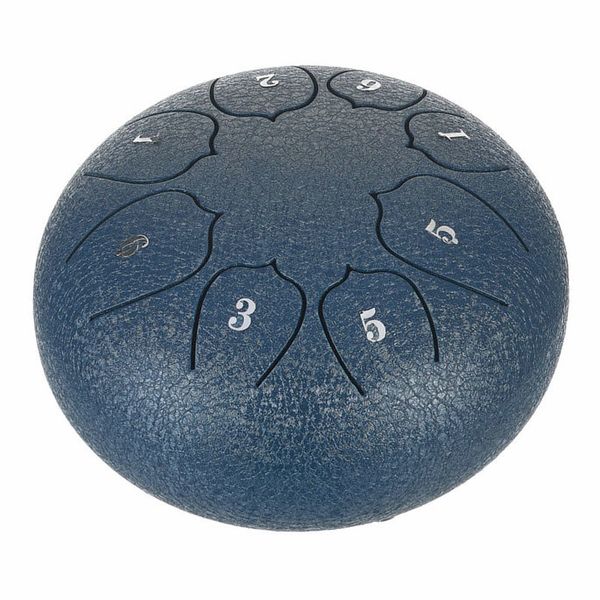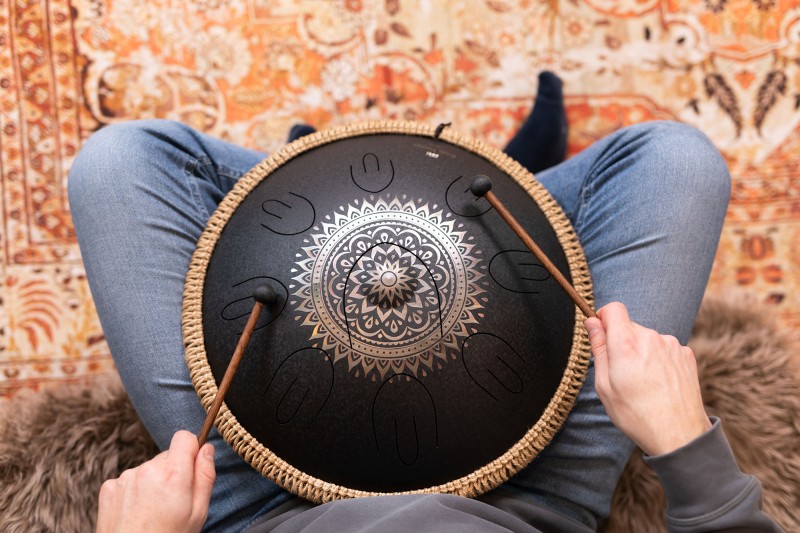Handpans are made from a single piece of steel with a convex dome shape, played with hands, and produce warm and mellow tones. Steel tongue drums are made from a sheet of steel with tongues cut into the top, played with mallets, and produce a more percussive sound with clearly defined notes.
differentiate table Between A Handpan And Steel Tongue Drum
| Handpan | Steel Tongue Drum |
|---|---|
| Made from a single piece of steel | Made from a sheet of steel with tongues cut into the top |
| Convex dome shape | Available in a variety of shapes and sizes |
| Played with hands | Played with mallets or drumsticks |
| Produces warm and mellow tones | Produces a more percussive sound with clearly defined notes |
| Has a center note and harmonics | Does not have harmonics and notes are arranged in a linear fashion |
| Often used for meditative and relaxing music | Used in a variety of music genres, including jazz, world music, and even heavy metal |
| Expensive due to complex construction and skill required | Less expensive than handpans |
| Can’t be tuned after production | Can be tuned after production by a professional |
Construction and Design

Handpans are crafted from a single piece of steel, and the top of the instrument is shaped like a convex dome. The handpan has a center note (usually in the key of D, E, or F) and a series of harmonics around it. The notes are arranged in a circular pattern, and the musician can produce different tones by striking the different areas of the dome.

On the other hand, steel tongue drums are typically made from a single sheet of steel and are available in a variety of shapes and sizes. The top of the drum is made up of tongues that are cut into the steel sheet and are then tuned to specific notes. Unlike handpans, steel tongue drums do not have harmonics, and the notes are arranged in a linear fashion.
Playing Techniques
The playing techniques for both instruments are quite different. Handpans are played with the hands, and the musician strikes the different areas of the dome to produce different tones. The musician can use the fingers, palms, or the back of the hands to create a variety of sounds. Handpans are often used for meditative or relaxing music due to their soothing tones.
On the other hand, steel tongue drums are played using mallets or drumsticks. The musician strikes the tongues of the drum to produce different notes. The sound produced by steel tongue drums is more percussive and can be used in a variety of music genres, including jazz, world music, and even heavy metal.
Sound Quality
The sound quality of handpans and steel tongue drums is quite different. Handpans are known for their warm and mellow tones, which make them perfect for meditative and relaxing music. The harmonics produced by handpans create a unique and ethereal sound that is often described as otherworldly.

On the other hand, steel tongue drums produce a more percussive sound that is similar to that of a steel drum or a xylophone. The sound is bright and crisp, and the notes are clearly defined. Steel tongue drums are often used in musical ensembles and can provide a unique layer of texture to a song.
What is the difference between handpan and hang drum?
The main difference between a handpan and a hang drum is that the hang drum is a trademarked instrument that is no longer in production, while the handpan is a newer, similar instrument that was developed after the hang drum.
Both instruments have a similar construction and sound, with a concave shape and a series of indentations that produce different notes when struck. However, the handpan has a slightly different layout of notes and can produce a wider range of tones than the hang drum.
Can you play a steel tongue drum with your hands?
Yes, you can play a steel tongue drum with your hands, as well as with mallets or drumsticks. In fact, many steel tongue drum players prefer to play with their hands as it allows for more nuanced and subtle playing.
When played with the hands, the steel tongue drum produces a warmer and more organic sound that is well-suited for meditative or relaxing music. However, playing with hands can also require more skill and technique than playing with mallets, so it may take some practice to master.
FAQs:
Can I tune my own steel tongue drum?
It is possible to tune your own steel tongue drum, but it requires a lot of skill and expertise. It is recommended to leave the tuning to a professional to avoid damaging the instrument.
Can I use mallets to play a handpan?
No, handpans are meant to be played with the hands. Using mallets can damage the surface of the dome and affect the sound quality of the instrument.
Are handpans and steel tongue drums expensive?
Yes, both instruments can be quite expensive. Handpans are typically more expensive than steel tongue drums due to the complexity of their construction and the skill required to make them.
who is the most famous handpan player?
Manu Delago is a famous handpan player known for his innovative and experimental approach to the instrument.
Conclusion
Ultimately, the choice between handpans and steel tongue drums comes down to personal preference and the type of music you want to play. If you’re looking for a soothing and meditative sound, a handpan may be the perfect choice for you. If you want to add a unique layer of texture to your music or play in a band, a steel tongue drum might be the better option.
Regardless of which instrument you choose, both handpans and steel tongue drums offer a unique and beautiful sound that is sure to captivate and enchant anyone who listens.



[…] first thing you need to know is that there are several types of microphones that you can use for handpans. The most common types are dynamic, condenser, and contact […]